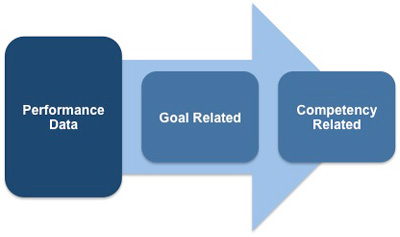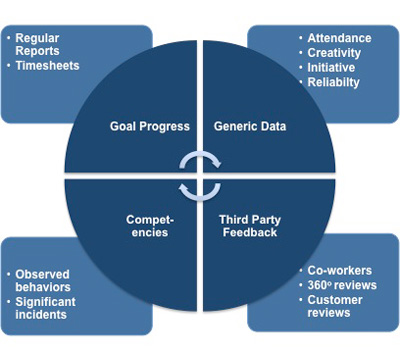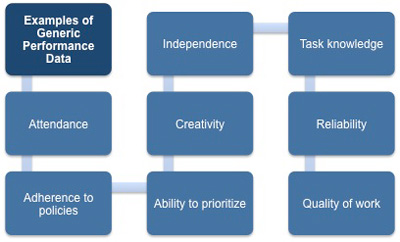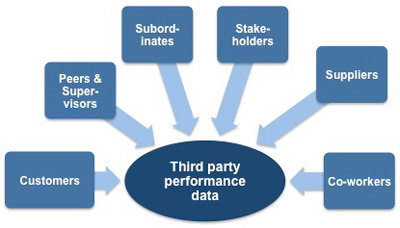Appraisal Data Collection
It is your responsibility to collect performance data from a variety of sources in order to provide yourself with an objective picture of the extent to which each team member has met their performance goals and displayed the competencies expected of their role.
Both of these factors are equally important since it would be possible for someone to achieve all of his or her performance goals whilst creating problems with customers, suppliers, and co-workers. In fact, focusing exclusively on the achievement of performance goals with no reference as to how they have been achieved can prove disastrous in the long term.
For example, if a sales person has achieved all of their sales targets by misleading customers about product functionality or delivery dates then this would impact on other people in the organization and may damage the reputation of the organization itself.
Similarly, a technical support team member might have a good record of resolving technical problems, but if they appear condescending towards customers then this will need to be dealt with before it causes damages the organization's image.
On a practical level, you should create a separate file for each of your team members; this can be a physical file or an electronic one. Just remember that physical copies of the performance data will be required for the appraisal meeting and for inclusion in the team member's personnel file.
 |
You may want to enter this data into a spreadsheet for each individual member and for the team as a whole as this will give you a quick reference point for assessing performance. This also enables you to quickly compare performance across your team so you can easily identify areas or people who are under-perform ing. Without valid and thorough performance data you will be unable to offer constructive feedback and relevant coaching to help them to improve.
Types of Data to Collect
There are a wide variety of options available to you as a manager for collecting data on the performance of each of your team members. These can be broadly categorized into four areas as shown in the diagram below.
 |
These categories are not exclusive. For example, a 'significant incident' could demonstrate that a team member possessed a required competency as specified in the role description, but it could also have contributed to the attainment of a goal. As in:
Your emotional intelligence and communication skills prevented the organization losing a key account and, furthermore, increasing the revenue from that account enabled you to meet your revenue targets.
When using job descriptions be sure to rate each item in terms of its contribution to the organization rather than in terms of the one that has the most responsibility or is the most time consuming. This offers you the perfect opportunity to regularly clarify and reinforce the organization's objectives.
Making this data collection something that you do on an ongoing basis will increase your overall effectiveness for several reasons. Firstly, it will enable you to collate first-hand information about new developments, problems, and training needs, as well as any issues and concerns your team may have. Secondly, regular meetings with each of your team members provide you with the ideal opportunity to give clear and specific feedback regarding their performance. Finally, the data collection process encourages you to regularly engage with your team members, something which has a positive impact on their motivation and morale.
One of the greatest benefits you will achieve as part of this continual monitoring of your team's performance is the ability to make better and more informed decisions as a result of using accurate and current data. This results in your decisions being more readily accepted and understood.
This is especially true for remuneration decisions, as they are based on factors that are fair, consistent, and tailored to individual performance. By providing a clear link between performance and remuneration, performance data allows remuneration decisions to be more transparent, equitable, and motivational. In contrast, this data also supports any disciplinary decisions you may need to make, since complete and objective performance data offers a robust defense against claims of wrongful dismissal.
Goal Progress
You can delegate a portion of the performance data collection to each team member in terms of their regular reporting. You can define these reports as part of the goals you set, or as part of a business function that the individual is responsible for or contributes to.
You are in the best position to know what kind of objective data is most relevant for your team and what helps you the most in your own reporting. For example:
For sales representatives it may be call reports, sales reports including potential revenue and likelihood of closing the sale, or reports listing the number of calls made over a particular period.
For information technology staff it may be project milestones, or charge or time sheets detailing work in progress and work completed.
For marketing staff it is a report outlining their progress according to the marketing plan and its targets.
Almost any quantifiable information that is a direct result of the individual's efforts should be dated and put into the file. Reports have a dual impact: they keep you aware of how each member is contributing and highlight to them how well they are performing against their goals or targets. The following templates are designed to help you in this area. The Goal Attainment Template enables you to track and evaluate an individual's progress in attaining their annual goals. The Competency Observation Template enables you to keep high-level notes on each team member's progress in developing their competencies and the Competency Evaluation Template allows you to record how and when an individual displayed the required competencies identified in their last appraisal.
Generic Data
This area of data collection often relates to the attitudes an individual portrays towards their role and the organization.
 |
For example:
- Is the person absent frequently? Are the absences affecting their performance?
- Does the individual follow organizational policies and procedures?
- Did they complete assignments in a timely manner and follow up appropriately?
- How well does the individual demonstrate an ability and willingness to cooperate and work effectively with others, including supervisors, co-workers, customers, suppliers, and the broader community?
- To what extent does the person seek out new assignments or additional responsibilities?
- Does the person show a commitment to safety at work in their performance?
All of these generic ways to measure performance need to be judged according to the person's job description and their contribution to the organization's success. It is also important to view any personnel data such as absenteeism, sickness, and accidents as potential indicators of poor performance.
Additional evidence for many of these generic factors can also be gained by talking to other people the team member has contact with.
Third Party Feedback
The first two methods of gathering performance data generally relate to your working relationship with the individual, but this only provides you with a narrow view of their performance. To gain a true appreciation of how well a person is performing and contributing to the organization, you need to gather data about the individual's relationship with third parties.
The type of data you can collect from these third parties will vary depending on the nature of your team and the individual's role. Examples include production schedules, product sales reports, geographical returns report, customer feedback, and peer evaluations. Be mindful of the individual's personal contribution to such data and view it as supplementary to your own performance data because of the subjective elements that are likely to be included.
 |
Remember, these measures may be subject to factors outside of the individual's control. For example, a sales person may be very effective at setting up meetings with prospective customers, making sales presentations, and gaining the opportunity to quote for the organization's services. But if the quotes provided are not competitive then the salesperson may be unfairly blamed for the lost sales.
You may also request your team leaders and supervisors to provide you with their own evaluations of an individual's performance or you may want to include a self-evaluation by the individual. You can also conduct a 360o feedback exercise where you seek feedback from subordinates, peers, supervisor(s), and a self-evaluation by the individual. If appropriate to the person's role you may want to include customers and suppliers or other interested stakeholders. Whilst this exercise can be extremely useful in providing data it can be time consuming and expensive to conduct.
You may also be interested in:
Evaluating Performance Appraisal | Evaluating Competencies | Performance Appraisal Rating Bias | Performance Appraisal Rating Scales | Performance Appraisal Reviews | Writing an Annual Performance Summary.



